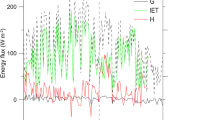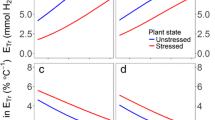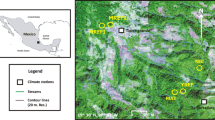Abstract
Foliar uptake of water from the surface of leaves is common when rainfall is scarce and non-meteoric water such as dew or fog is more abundant. However, many species in more mesic environments have hydrophobic leaves that do not allow the plant to uptake water. Unlike foliar uptake, all species can benefit from dew- or fog-induced transpiration suppression, but despite its ubiquity, transpiration suppression has so far never been quantified. Here, we investigate the effect of dew-induced transpiration suppression on the water balance and the isotope composition of leaves via a series of experiments. Characteristically, hydrophobic leaves of a tropical plant, Colocasia esculenta, are misted with isotopically enriched water to reproduce dew deposition. This species does not uptake water from the surface of its leaves. We measure leaf water isotopes and water potential and find that misted leaves exhibit a higher water potential and a more depleted water isotope composition than dry leaves, suggesting a ∼ 30% decrease in transpiration rate compared to control leaves. We propose three possible mechanisms governing the interaction of water droplets with leaf energy balance: increase in albedo from the presence of dew droplets, decrease in leaf temperature from the evaporation of dew, and local decrease in vapor pressure deficit. Comparing previous studies on foliar uptake to our results, we conclude that transpiration suppression has an effect of similar amplitude, yet opposite sign to foliar uptake on leaf water isotopes.



Similar content being viewed by others
References
Agam N, Berliner PR (2006) Dew formation and water vapor adsorption in semi-arid environments—a review. J Arid Environ 65(4):572–590
Aparecido LMT, Miller GR, Cahill AT, Moore GW (2017) Leaf surface traits and water storage retention affect photosynthetic responses to leaf surface wetness among wet tropical forest and semiarid savanna plants. Tree Physiol. https://doi.org/10.1093/treephys/tpx092
Baguskas SA, King JY, Fischer DT, D’Antonio CM, Still CJ (2017) Impact of fog drip versus fog immersion on the physiology of Bishop pine saplings. Funct Plant Biol 44(3):339–412
Bartlett MK, Scoffoni C, Sack L (2012) The determinants of leaf turgor loss point and prediction of drought tolerance of species and biomes: a global meta-analysis. Ecol Lett 15(5):393–405
Berkelhammer M, Hu J, Bailey A, Noone DC, Still CJ, Barnard H, Turnipseed A (2013) The nocturnal water cycle in an open-canopy forest. J Geophys Res Atmos 118(1):10225
Berry ZC, Smith WK (2014) Experimental cloud immersion and foliar water uptake in saplings of Abies fraseri and Picea rubens. Trees 28(1):115–123
Berry ZC, Hughes NM, Smith WK (2014a) Cloud immersion: an important water source for spruce and fir saplings in the southern Appalachian Mountains. Oecologia 174(2):319–326
Berry ZC, White JC, Smith WK (2014b) Foliar uptake, carbon fluxes and water status are affected by the timing of daily fog in saplings from a threatened cloud forest. Tree Physiol 34(5):459–470
Beysens D (1995) The formation of dew. Atmos Res 39(1):215–237
Breshears DD, McDowell NG, Goddard KL, Dayem KE, Martens SN, Meyer CW, Brown KM (2008) Foliar absorption of intercepted rainfall improves woody plant water status most during drought. Ecology 89(1):41–47
Burgess S, Dawson TE (2004) The contribution of fog to the water relations of Sequoia sempervirens (D. Don): foliar uptake and prevention of dehydration. Plant Cell Environ 27(8):1023–1034
Cernusak LA, Kahmen A (2013) The multifaceted relationship between leaf water 18O enrichment and transpiration rate. Plant Cell Environ 36(7):1239–1241
Chang E, Wolf A, Gerlein-Safdi C, Caylor KK (2016) Improved removal of volatile organic compounds for laser-based spectroscopy of water isotopes. Rapid Commun Mass Spectrom 30(6):784–790
Craig H, Gordon LI (1965) Deuterium and oxygen-18 variations in the ocean and the marine atmosphere. In: Proceedings of a conference on stable isotopes in oceanographic studies and palaeotemperatures, pp 9–130
Cui J, Tian L, Gerlein-Safdi C, Qu D (2017) The influence of memory, sample size effects, and filter paper material on online laser-based plant and soil water isotope measurements. Rapid Commun Mass Spectrom 31(6):509–522
Dawson TE (1998) Fog in the California redwood forest: ecosystem inputs and use by plants. Oecologia 117(4):476–485
Defraeye T, Verboven P, Derome D, Carmeliet J, Nicolai B (2013) Stomatal transpiration and droplet evaporation on leaf surfaces by a microscale modelling approach. Int J Heat Mass Transf 65:180–191
Dennis KJ, Rees-Owen RL, Brooks PD, Carter J, Dawson TE (2014) Expanding the scope and applicability of laser-based spectroscopy to studies of ecohydrology by removing organic contaminants in natural water. In: AGU fall meeting abstracts, G683
Dubbert M, Cuntz M, Piayda A, Maguás C, Werner C (2013) Partitioning evapotranspiration—testing the Craig and Gordon model with field measurements of oxygen isotope ratios of evaporative fluxes. J Hydrol 496(C):142–153
Dubbert M, Cuntz M, Piayda A, Werner C (2014) Oxygen isotope signatures of transpired water vapor: the role of isotopic non-steady-state transpiration under natural conditions. New Phytol 203(4):1242–1252
Eller CB, Lima AL, Oliveira RS (2013) Foliar uptake of fog water and transport belowground alleviates drought effects in the cloud forest tree species, Drimys brasiliensis (Winteraceae). New Phytol 199(1):151–162
Farquhar GD, Cernusak LA (2005) On the isotopic composition of leaf water in the non-steady state. Funct Plant Biol 32(4):293
Farquhar GD, Hubick KT, Condon AG, Richards RA (1989) Stable isotopes in ecological research. In: Rundel P, Ehleringer J, Nagy K (eds) Stable isotopes in ecological research. Springer, New York, pp 21–40
Farquhar GD, Cernusak LA, Barnes B (2006) Heavy water fractionation during transpiration. Plant Physiol 143(1):11–18
Frolking S, Milliman T, Palace M, Wisser D, Lammers R, Fahnestock M (2011) Tropical forest backscatter anomaly evident in SeaWinds scatterometer morning overpass data during 2005 drought in Amazonia. Remote Sens Environ 115(3):897–907
Garratt JR, Segal M (1988) On the contribution of atmospheric moisture to dew formation. Bound Layer Meteorol 45(3):209–236
Gerlein-Safdi C, Gauthier PPG, Sinkler CJ, Caylor KK (2017) Leaf water 18O and 2H maps show directional enrichment discrepancy in Colocasia esculenta. Plant Cell Environ 40(10):2095–2108
Goldsmith GR, Lehmann MM, Cernusak LA, Arend M, Siegwolf RTW (2017) Inferring foliar water uptake using stable isotopes of water. Oecologia 184(4):763–766
Gotsch SG, Asbjornsen H, Holwerda F, Goldsmith GR, Weintraub AE, Dawson TE (2013) Foggy days and dry nights determine crown-level water balance in a seasonal tropical montane cloud forest. Plant Cell Environ 37(1):261–272
Hill AJ, Dawson TE, Shelef O, Rachmilevitch S (2015) The role of dew in Negev Desert plants. Oecologia 178(2):317–327
Hughes AP, Cockshull KE, Heath OVS (1970) Leaf area and absolute leaf water content. Ann Bot 34(2):259–266
Jones HG (1992) Plants and microclimate: a quantitative approach to environmental plant physiology. Cambridge University Press, Cambridge
Kaseke KF, Wang L, Seely MK (2017) Nonrainfall water origins and formation mechanisms. Sci Adv 3(3):e1603131
Kim K, Kim H, Ho Park S, Joon Lee S (2017) Hydraulic strategy of cactus trichome for absorption and storage of water under arid environment. Front Plant Sci 8:3235–3238
Lakatos M, Obregón A, Büdel B, Bendix J (2012) Midday dew—an overlooked factor enhancing photosynthetic activity of corticolous epiphytes in a wet tropical rain forest. New Phytol 194(1):245–253
Lambers H, Chapin FS III, Pons TL (2008) Plant physiological ecology. Springer, New York
Lhomme JP, Elguero E, Chehbouni A, Boulet G (1998) Stomatal control of transpiration: examination of Monteith’s formulation of canopy resistance. Water Resour Res 34(9):2301–2308
Limm EB, Simonin KA, Bothman AG, Dawson TE (2009) Foliar water uptake: a common water acquisition strategy for plants of the redwood forest. Oecologia 161(3):449–459
Luz B, Barkan E, Yam R, Shemesh A (2009) Fractionation of oxygen and hydrogen isotopes in evaporating water. Geochim Cosmochim Acta 73(22):6697–6703
Mabhaudhi T, Modi AT, Beletse YG (2013) Response of taro (Colocasia esculenta L. Schott) landraces to varying water regimes under a rainshelter. Agric Water Manag 121:102–112
Maxwell JO, Redmann RE (1978) Leaf water potential, component potentials and relative water content in a xeric grass, Agropyron dasystachyum (Hook.) Scribn. Oecologia 35(3):277–284
McLaughlin BC, Ackerly DD, Klos PZ, Natali J, Dawson TE, Thompson SE (2017) Hydrologic refugia, plants, and climate change. Glob Chang Biol 66:107–121
Miyazawa Y, Tateishi M, Komatsu H, Kumagai T, Otsuki K (2011) Are measurements from excised leaves suitable for modeling diurnal patterns of gas exchange of intact leaves? Hydrol Process 25(18):2924–2930
Monteith JL (1965) Evaporation and environment. Symp Soc Exp Biol 19:205–234
Morse SR (1990) Water balance in Hemizonia luzulifolia: the role of extracellular polysaccharides. Plant Cell Environ 13(1):39–48
Neinhuis C, Barthlott W (1997) Characterization and distribution of water-repellent, self-cleaning plant surfaces. Ann Bot 79(6):667–677
Njintang NY, Boudjeko T, Tatsadjieu LN, Nguema-Ona E, Scher J, Mbofung CMF (2014) Compositional, spectroscopic and rheological analyses of mucilage isolated from taro (Colocasia esculenta L. Schott) corms. Journal of Food Science and Technology 51(5):900–907
Oliveira RS, Eller CB, Bittencourt PRL, Mulligan M (2014) The hydroclimatic and ecophysiological basis of cloud forest distributions under current and projected climates. Ann Bot 113(6):909–920
Onwueme IC, Johnston M (2000) Influence of shade on stomatal density, leaf size and other leaf characteristics in the major tropical root crops, tannia, sweet potato, yam, cassava and taro. Exp Agric 36(4):509–516
Ozturk I, Ottosen C-O, Ritz C (2013) The effect of temperature on photosynthetic induction under fluctuating light in Chrysanthemum morifolium. Acta Physiol Plant 35(4):1179–1188
Pinter PJ (1986) Effect of dew on canopy reflectance and temperature. Remote Sens Environ 19(2):187–205
Price JD, Clark R (2014) On the measurement of dewfall and fog-droplet deposition. Bound-Layer Meteorol 152(3):367–393
Quach ML, Melton LD, Harris PJ, Burdon JN, Smith BG (2001) Cell wall compositions of raw and cooked corms of taro (Colocasia esculenta). J Sci Food Agric 81(3):311–318
Risi C, Landais A, Winkler R, Vimeux F (2013) Can we determine what controls the spatio-temporal distribution of d-excess and 17O-excess in precipitation using the LMDZ general circulation model? Clim Past 9(5):2173–2193
Ruxton GD (2006) The unequal variance t test is an underused alternative to Student’s t test and the Mann-Whitney U test. Behav Ecol 17(4):688–690
Satake M, Hanado H (2004) Diurnal change of Amazon rain forest σ0 observed by Ku-band spaceborne radar. IEEE Trans Geosci Remote Sens 42(6):1127–1134
Scholl M, Eugster W, Burkard R (2010) Understanding the role of fog in forest hydrology: stable isotopes as tools for determining input and partitioning of cloud water in montane forests. Hydrol Process 25(3):353–366
Smith WK, Berry ZC (2013) Sunflecks? Tree Physiol 33(3):233–237
Stanton DE, Horn HS (2013) Epiphytes as “filter-drinkers”: life-form changes across a fog gradient. Bryol 116(1):34–42
Tolk JA, Howell TA, Steiner JL, Krieg DR, Schneider AD (1995) Role of transpiration suppression by evaporation of intercepted water in improving irrigation efficiency. Irrig Sci 16(2):89–95
van Geldern R, Barth JAC (2012) Optimization of instrument setup and post-run corrections for oxygen and hydrogen stable isotope measurements of water by isotope ratio infrared spectroscopy (IRIS). Limnol Oceanogr Methods 10:1024–1036
Voelker SL, Brooks JR, Meinzer FC, Roden J, Pazdur A, Pawelczyk S, Šantrůček J (2014) Reconstructing relative humidity from plant δ18O and δD as deuterium deviations from the global meteoric water line. Ecol Appl 24(5):960–975
Wang L, Kaseke KF, Seely MK (2016) Effects of non-rainfall water inputs on ecosystem functions. Wiley Interdiscip Rev Water 4(1):e1179
Wayland H (2015) An ecohydrological characterization of two African savanna trees under water stress. (Unpublished master’s thesis). Princeton University
West JB, Bowen GJ, Dawson TE, Tu KP (2009) Isoscapes. Springer, Berlin
West AG, Goldsmith GR, Brooks PD, Dawson TE (2010) Discrepancies between isotope ratio infrared spectroscopy and isotope ratio mass spectrometry for the stable isotope analysis of plant and soil waters. Rapid Commun Mass Spectrom 24(14):1948–1954
Yates DJ, Hutley LB (1995) Foliar uptake of water by wet leaves of Sloanea woollsii, an Australian subtropical rainforest tree. Aust J Bot 43(2):157–167
Zhang Y-F, Wang X-P, Pan Y-X, Hu R (2012) Diurnal and seasonal variations of surface albedo in a spring wheat field of arid lands of Northwestern China. Int J Biometeorol 57(1):67–73
Acknowledgments
CGS and KKC acknowledge the financial support of NASA Headquarters under the NASA Earth and Space Science Fellowship Program—Grant 14-EARTH14F-241—and of a Mary and Randall Hack’69 Graduate Award and the Science, Technology, and Environmental Policy Fellowship from the Princeton Environmental Institute. CGS thanks Missy Holbrook and the Department of Organismic and Evolutionary Biology at Harvard University for hosting her during part of this work.
Author information
Authors and Affiliations
Contributions
CGS, PPGG, and KKC designed the study. CGS collected and analyzed the data. CGS, PPGG, and KKC wrote the paper.
Corresponding author
Additional information
Communicated by Miquel A Gonzalez-Meler.
Rights and permissions
About this article
Cite this article
Gerlein-Safdi, C., Gauthier, P.P.G. & Caylor, K.K. Dew-induced transpiration suppression impacts the water and isotope balances of Colocasia leaves. Oecologia 187, 1041–1051 (2018). https://doi.org/10.1007/s00442-018-4199-y
Received:
Accepted:
Published:
Issue Date:
DOI: https://doi.org/10.1007/s00442-018-4199-y




